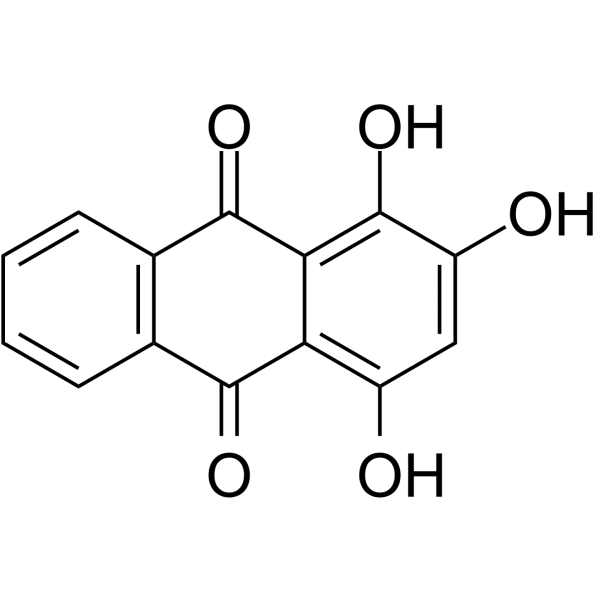Physicochemical Properties
| Molecular Formula | C14H8O5 |
| Molecular Weight | 256.2103 |
| Exact Mass | 256.037 |
| CAS # | 81-54-9 |
| PubChem CID | 6683 |
| Appearance | Pink to red solid powder |
| Density | 1.7±0.1 g/cm3 |
| Boiling Point | 525.1±45.0 °C at 760 mmHg |
| Melting Point | 253-256ºC(lit.) |
| Flash Point | 285.4±25.2 °C |
| Vapour Pressure | 0.0±1.4 mmHg at 25°C |
| Index of Refraction | 1.773 |
| LogP | 4.6 |
| Hydrogen Bond Donor Count | 3 |
| Hydrogen Bond Acceptor Count | 5 |
| Rotatable Bond Count | 0 |
| Heavy Atom Count | 19 |
| Complexity | 407 |
| Defined Atom Stereocenter Count | 0 |
| InChi Key | BBNQQADTFFCFGB-UHFFFAOYSA-N |
| InChi Code | InChI=1S/C14H8O5/c15-8-5-9(16)14(19)11-10(8)12(17)6-3-1-2-4-7(6)13(11)18/h1-5,15-16,19H |
| Chemical Name | 1,2,4-trihydroxyanthracene-9,10-dione |
| HS Tariff Code | 2934.99.9001 |
| Storage |
Powder-20°C 3 years 4°C 2 years In solvent -80°C 6 months -20°C 1 month Note: This product requires protection from light (avoid light exposure) during transportation and storage. |
| Shipping Condition | Room temperature (This product is stable at ambient temperature for a few days during ordinary shipping and time spent in Customs) |
Biological Activity
| ln Vivo | Purpurin (Orally; 2, 6, 18 mg/kg for 3 weeks) affects behavior and stress axis reactivity in adult male C57BL/6J mice in a dose-dependent manner (6-7 weeks old upon arrival)[1]. |
| References |
[1].Purpurinexerted antidepressant-like effects on behavior and stress axis reactivity: evidence of serotonergic engagement. Psychopharmacology (Berl).2020 Mar;237(3):887-899. |
| Additional Infomation |
Purpurin is a trihydroxyanthraquinone derived from anthracene by substitution with oxo groups at C-9 and C-10 and with hydroxy groups at C-1, C-2 and C-4. It has a role as a biological pigment, a histological dye and a plant metabolite. Purpurin has been reported in Rubia argyi, Rubia wallichiana, and other organisms with data available. See also: Rubia tinctorum root (part of). |
Solubility Data
| Solubility (In Vitro) | DMSO : ~125 mg/mL (~487.88 mM) |
| Solubility (In Vivo) |
Solubility in Formulation 1: 10 mg/mL (39.03 mM) in 10% DMSO + 40% PEG300 + 5% Tween80 + 45% Saline (add these co-solvents sequentially from left to right, and one by one), suspension solution; with sonication. For example, if 1 mL of working solution is to be prepared, you can add 100 μL of 100.0 mg/mL clear DMSO stock solution to 400 μL PEG300 and mix evenly; then add 50 μL Tween-80 to the above solution and mix evenly; then add 450 μL normal saline to adjust the volume to 1 mL. Preparation of saline: Dissolve 0.9 g of sodium chloride in 100 mL ddH₂ O to obtain a clear solution. Solubility in Formulation 2: 10 mg/mL (39.03 mM) in 10% DMSO + 90% Corn Oil (add these co-solvents sequentially from left to right, and one by one), suspension solution; with ultrasonication. For example, if 1 mL of working solution is to be prepared, you can add 100 μL of 100.0 mg/mL clear DMSO stock solution to 900 μL of corn oil and mix evenly. (Please use freshly prepared in vivo formulations for optimal results.) |
| Preparing Stock Solutions | 1 mg | 5 mg | 10 mg | |
| 1 mM | 3.9030 mL | 19.5152 mL | 39.0305 mL | |
| 5 mM | 0.7806 mL | 3.9030 mL | 7.8061 mL | |
| 10 mM | 0.3903 mL | 1.9515 mL | 3.9030 mL |
